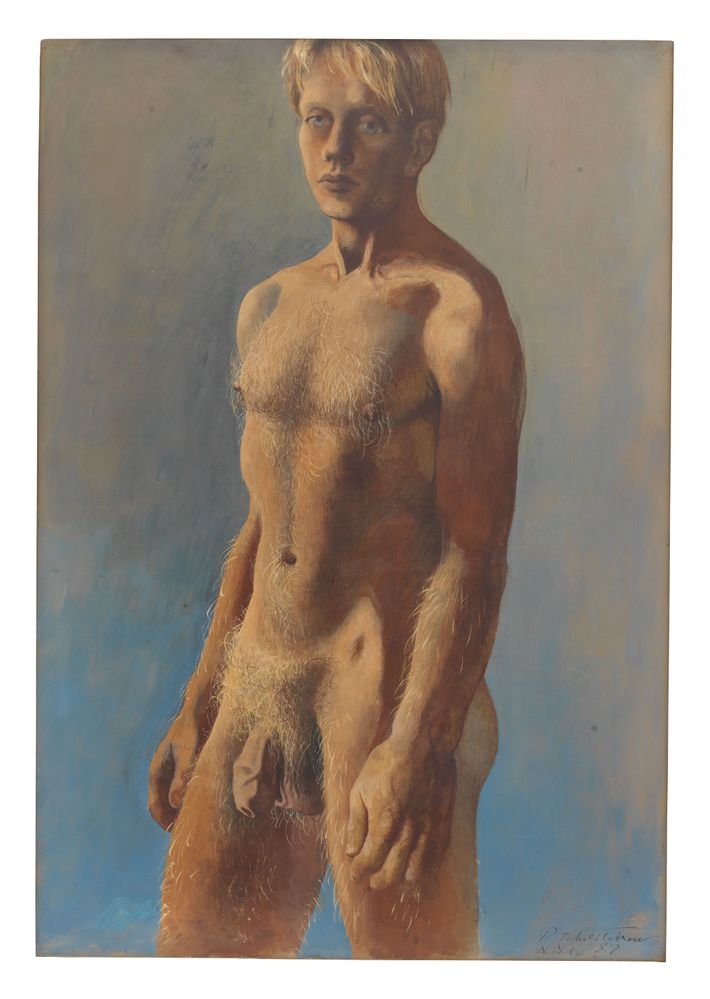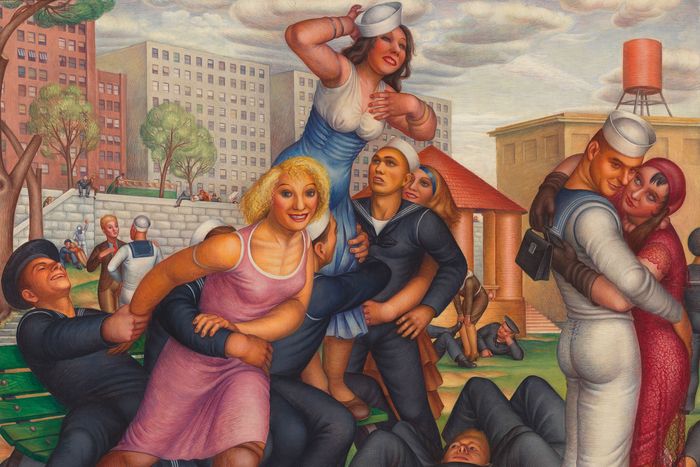
The first gallery of ÔÇ£The Young and EvilÔÇØ is one of the most reactionary yet radical visions of art on offer anywhere in New York right now. Most viewers wonÔÇÖt be familiar with the names of the artists on display ÔÇö Paul Cadmus, Jared French, and Pavel Tchelitchew (pronounced Shell-ah-chev) ÔÇö or with their unapologetically queer paintings made between 1933 and 1950. No matter, the show ÔÇö itÔÇÖs lovingly organized by critic Jarrett Earnest and should be expanded into a much larger one at a museum ÔÇö is an overdue reintroduction to a number of artists whose work is rarely on display, either because itÔÇÖs deemed in bad taste (often itÔÇÖs outright kitsch), irrelevant to modernism (itÔÇÖs not), or too graphically homosexual for public view (maybe it is! Or has been, at least). In equal parts X-rated, salacious, hysterically funny, erotic, violent, fantasy-based, brave, and a wonderful record of secret lives, this first show and much that follows will inspire young artists ÔÇö especially those looking for confirmation that styles deemed retrograde or conservative may be reignited in revolutionary ways by being deployed in new contexts and with new subject matter. Earnest theorizes, ÔÇ£Another modernism existed, beating at the very heart of New YorkÔÇÖs culture in the early-20th century. [The artists and writers in this show] were new social creatures, playfully and boldly homosexual at a time when it was both criminalized and pathologized. They pursued a modernism of the body ÔÇö driven by eroticism and bounded by intimacy.ÔÇØ George BellowsÔÇÖs boxer was sinewy; Thomas Hart BentonÔÇÖs farmers were willowy. The bodies in this show are sensual, on display, sexually presenting, in carnal states of being ÔÇö all expressing an otherwise forbidden and reviled sexuality. The artists here knew deeply whereof they spoke in this expanded erogenous field of art.
Most of the artists here also knew one another intimately. Some were lovers; others were married to one another; some were in bearded marriages (accepted in high society and the bohemian milieu); others were in ongoing throuples. Yet community and outr├® styles arenÔÇÖt what make this show so explosive. ItÔÇÖs that none of the sex and sexuality in ÔÇ£YoungÔÇØ is coded, secreted with symbols, shrouded, romanticized, abstracted, or allegorized. Everything is unmistakably, audaciously out in the open. This feels rather bold even now, believe it or not, but it is downright shocking to consider as an artifact of interwar America. As you go through the show, remember that in a whole artistic generation later, when homosexuality was finally decriminalized in the 1960s, not Johns, Rauschenberg, Twombly, Kelley, Indiana, or even Warhol was as openly out as many of these artists are. They all were far more coded. (Although when the police entered WarholÔÇÖs Factory 15 minutes after his 1968 shooting, they openly mocked the homosexuality they saw in the work scattered about.)
This show suggests that contrary to the accepted formal telling of art history, which proceeds ism by ism, style by style, through a series of deducible formal developments (Fauvism, Cubism, Constructivism, Expressionism, Surrealism, on up to Minimalism, etc.), subject matter may also make art modern. And not by half-measures. Ashcan painters like Bellows and Robert Henri did this by painting the underclass of American life: wrestlers, workers, working girls, protesters. Benton did similar things, making serpentine mural paintings of rural life and country farmers. But these artists did this with their new subject matter while still explicitly adding modern flourishes, Post-Impressionist and Expressionistic elements. This signaled to all that their art was trying to be different in form as well as subject matter. Not so the artists in EarnestÔÇÖs show. Almost everything here could be mistaken at first glance for Neo-Classical depictions of the human body in rigid, academic spatial composition. Tight rendering apes early- and late-Renaissance style and color. A few of the works look like they could have come from the villas of Roman emperors. Which is sort of insanely corny when you think about it, not to say risky for a 20th-century modern artist. The wild radicality in these artists comes in that they used these absolutely bygone and ÔÇ£properÔÇØ styles as the visual delivery vehicle for such brazenly gay subject matter. This wasnÔÇÖt scrapbooking art history to return to any golden Pre-Raphaelite era. This was about asserting the rightful place of the homosexual body in art after almost 2,000 years of exile and revulsion. Talk about ÔÇ£making it newÔÇØ!
The show announces its intentions right at the start with TchelitchewÔÇÖs riveting, erotic The Lion Boy (1936ÔÇô37). This boy is seen in archaic Roman wall-painting mode, Pompeian pleasure-palace fresco, or high-camp Felliniesque lasciviousness. We see a young naked David-like boy, looking away from us, a blond Adonis lion-god lost in thought, passive but aware, observant, charged with bodily potential and possible agency. The painterly details are unlike anything after the fall of the Western Roman Empire. His golden chest hairs shimmer in the sun; the raised veins leading to his foreskin pulse; his forehead ever so slightly bruised gives us this ÔÇ£baby man,ÔÇØ or rough trade, or just a boy at the beach. (Think Tadzio, the 14-year-old Polish bather in Death in Venice.) We havenÔÇÖt seen the male homosexual gaze this amped up on the main stage of Western painting for two millennium.
Much of the work in this show borders on illustration, drafting, journalistic depiction, and other supposedly commercial styles. It abounds with historical references to Etruscan sculpture, social realism, WPA mural painting, illuminated manuscripts, Durer, Cranach, and more. In other words, these artists sidestepped or rejected the powerful modernisms of the time ÔÇö ideas that were sweeping the world of art ÔÇö like Cubism, Futurism, Constructivism, Dada, and abstraction. At the time the artists in ÔÇ£YoungÔÇØ were trying to make it new with their queering of art, almost all other artists were coming to terms with, or desperately trying to adapt to and build on, European modernism. Which meant that any artist doing what this crew was doing with such flamboyant sauciness and in-your-face homosexuality was considered out-of-it, suicidal, even unhinged. No matter, thatÔÇÖs what these artists risked doing and did. We are grateful.
In CadmusÔÇÖs 1933 Shore Leave, we see transvestites in dresses and menÔÇÖs shoes dance in Riverside Park with beefy sailors; a handsome serviceman embraces either a woman dressed as a man or an effeminate man; all manner of male beefcake, musculature, naked chests, and more are pictured. In ÔÇ£Young,ÔÇØ youÔÇÖll see some of the weirdest realisms youÔÇÖve set eyes on in some time. Such freedom, bawdiness, joy, and almost Disneyesque innocence and nuttiness.
In addition to explicit photos of erections, self-fellatio, drawings and watercolors so out-there that theyÔÇÖre owned by the Kinsey Institute, and other pictures of all sorts of sexualities, I call your attention to the most riveting work here, CadmusÔÇÖs 1939ÔÇô40 oil-and-tempera Stone Blossom: A Conversation Piece. Tightly rendered in opaque shades of green and brown and saturated whites, three buff men lounge under a tree on the lawn of a large New Jersey country home. ItÔÇÖs the throuple of famous photographer George Platt Lynes in loincloth ÔÇö lying on his side like a modern Apollo odalisque, unashamed, nonchalant yet voguing, presenting himself as a specimen of delectation. Next to him, on his knees, the famous expat novelist Glenway Wescott. HeÔÇÖs adorned in his best open motorcycle jacket, jeans, and T-shirt, brooding in a bad-boy pose ÔÇö his true colors shining through. ThereÔÇÖs a superrealistic print of a hawk in front of him. It symbolizes his great 1940 book, The Pilgrim Hawk. On the left, leaning on the tree is a shirtless Monroe Wheeler reading an art publication that ÔÇö if you look very closely inside ÔÇö has a headline about a small new museum where he was director of publications, the Museum of Modern Art. Even if you donÔÇÖt know any of this, the intensity of depiction, the finely rendered figures, the relaxed seething sexuality, obsessive surface, and obvious passion will infuse any viewer with stupefied respect.
See this show. It connects to things artists are doing now: saying no to the rules of art history; breaking out of their lanes; inhabiting spaces and styles that have been dismissed. The way the artists in ÔÇ£The Young and EvilÔÇØ introduced queerness into art connects to the work of lots of young queer artists and artists of color such as Lynette Yiadom-Boakye, Jordan Castile, Njideka Akunyili Crosby, Jon Key, Bianca Nemlec, Louie Fratino, Hiba Schahbaz, and Toyin Ojih Odutola. All these artists work in what might be called near-academic or illustrational realisms, later-day photo-realism, illuminated Persian manuscript, or even Romare BeardenÔÇô and Jacob LawrenceÔÇôinspired Picasso-esque Cubisms. But these new artists are using the strategies of ÔÇ£YoungÔÇØ in order to forcefully and once and for all claim space for black, brown, and Asian bodies. All with individuality, agency, purpose, desirability, and psychological complexity. Kerry James Marshall has been doing this with history painting for decades, while Nina Chanel Abney does similar things via the wild American proto-Pop Cubism of Stuart Davis. One of the thrusts of ÔÇ£YoungÔÇØ is that by introducing the contemporary faces, bodies, modern sexualities, conflicts, contexts, class divisions, body languages, and fashions where they have been banned from Western art for thousands of years ÔÇö that doing this, even with supposedly dated styles, can make the old new and transgressive again.
As for how firebrand some of this work is: IÔÇÖd be banned from Instagram in a flash were I to post much of whatÔÇÖs in this show. Yet this art is at the very center of American modernism, showing that the idea that the image itself is charged by who is being pictured and who is doing the picturing ÔÇö it is like harnessing a fire. In doing this, new artists across the board are actually in the act of changing the course of art history. See this show for one of the origins of this fire.
The Young and Evil is open at David Zwirner, 533 W. 19th St., through April 13.



